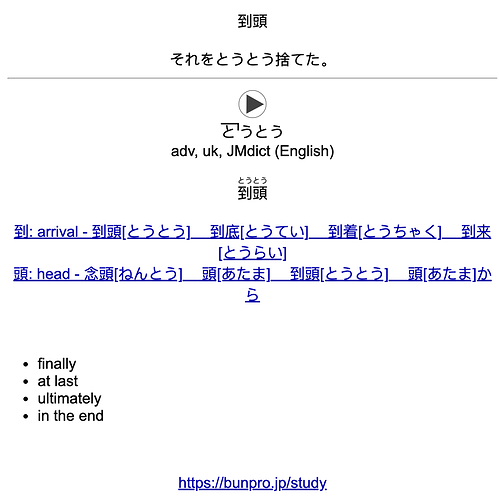I modified it beyond recognition though. I try to do pretty much what you said plus:
- I break down kanji to theirs radicals to make them easier to remember.
- I did some work upfront to make it easier later. When I have extra time I add more kanji from 5100 novels frequency list. I stopped at position 757 which give 83% percent coverage and I know quite a lot after that (I would guess about 90%+ coverage) but there are quite rare one in my deck as well like 髭 (position about 1800) and 苺 (quite far away after 3000) since it was in the text, or other that are just radicals not much used if at all as kanji (I don’t add to deck if they are never in Kanji form though).
- I do my best to not disassociate them from readings and vocab. On this part Heisig misunderstood basic neurology: you want you knowledge to interact in messy way. That’s how brain works.
I did try to make “readings” deck but it was huge waste of time. I prefer learn reading from vocab. Fits better to that “knowledge soup” I am cooking in my head.
That’s why I was worried if that may be lazy life hack xD. But sometimes being lazy is smart 
I did notice it is starting to get pointless at this point  But there was good reason for giving Kanji some special love:
But there was good reason for giving Kanji some special love:
I am ready to defend claim that Japanese - if you ignore cultural difference - is easier than English because of Kanji. Kanji makes it easier to remember and read. It would be great if there was only one reading per kanji but it is still easier to remember than random string of letters. And my memory is bad, so Kanji is huge help. And is far more natural to our brains. That’s why we invented it first, and thats why Chinese and Japanese people read a lot faster and people “speed reading” (no pronunciation in your head, just ideas) are not as uncommon thing there as far as I know.
That basically only reason why I have separated deck for Kanji. They are tools to help me with vocab. It is important for me tool. Better know it well then. 
Thank you for pointing this out. That would be quite a huge mistake on my part if we would disagree much on this aspect of learning Kanji so better to make it clear 
Edit: I can speak all day about my love to kanji xD


